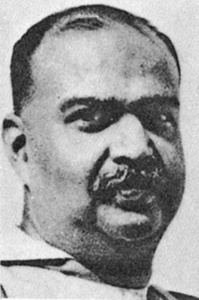Dissolved 1977 Dissolution 1977 | Colours Orange Founded 21 October 1951 Color Orange | |
 | ||
Succeeded by Bharatiya Janata Party (1980–) | ||
The Bharatiya Jana Sangh ( BJS), commonly known as the Jan Sangh, was an Indian nationalist political party that existed from 1951 to 1977 and was the political arm of Rashtriya Swayamsevak Sangh (RSS), a Hindu right-wing organisation. In 1977, it merged with several other left, centre and right parties opposed to rule of the Indian National Congress and formed the Janata Party. After the Janata Party split in 1980, it was re-formed as the Bharatiya Janata Party (BJP) in 1980, which is currently India's largest political party by primary membership and representation in Lok Sabha.
Contents
Origins
The BJS was started by Syama Prasad Mookerjee on 21 October 1951 in Delhi in collaboration with the Rashtriya Swayamsevak Sangh (RSS) as a "nationalistic alternative" to the India Congress. After the death of Mookerjee, the RSS activists in the party edged out the career politicians and made it a political arm of the RSS and an integral part of the RSS family of organisations (Sangh Parivar).
The symbol of the party in Indian elections was an oil lamp and like the RSS, its ideology was centred on Hindutva. In the 1952 general elections to the Parliament of India, Bharatiya Jana Sangh won three seats, Mookerjee being one of the winning candidates. The BJS would often link up on issues and debates with the right-wing Swatantra Party of Chakravarti Rajagopalachari. Its strongest parliamentary performance came in the 1967 elections, when the Congress majority was its thinnest ever.
Ideology
The BJS was ideologically close to the Rashtriya Swayamsevak Sangh, and derived most of its political activist base and candidates from the RSS ranks.
The BJS also attracted many economically conservative members of the Indian National Congress who were disenchanted with the more socialist policies and politics of Jawaharlal Nehru and the Congress Party. The BJS's strongest constituencies were in Rajasthan, Gujarat, Maharashtra, Madhya Pradesh, Bihar and Uttar Pradesh.
The BJS leadership strongly supported a stringent policy against Pakistan and China, and were averse to the USSR and communism. Many BJS leaders also inaugurated the drive to ban cow slaughter nationwide in the early 1960s.
During the Emergency of 1975
In 1975, Indira Gandhi declared a state of Emergency, and threw many major opposition politicians in jail including the leaders of the BJS. In 1977, the Emergency was withdrawn, and elections were held. The BJS, joined forces with the Bharatiya Lok Dal, the Congress (O), and the Socialist Party, to form the Janata Party (People's Party). The Janata Party became the first Indian government not led by the Indian National Congress. Former BJS leaders Atal Bihari Vajpayee and L. K. Advani became the External Affairs (Foreign), and Information and Broadcasting Ministers respectively.
Chronological list of presidents
In general elections
The Bharatiya Jana Sangh was created in 1951, and the first general election it contested was in 1951-52, in which it won only three Lok Sabha seats, in line with the four seats won by Hindu Mahasabha and three seats won by Ram Rajya Parishad. Shyama Prasad Mookerjee and Durga Charan Banerjee were elected from Bengal and Uma Shankar Trivedi from Rajasthan. All the like-minded parties formed a block in the Parliament, led by Shyama Prasad Mookerjee.
The party steadily improved its electoral performance until, as a constituent of the Janata Party in 1977, it won 94 seats.
Formation of BJP (1980 onwards)
After the Janata Party's poor showing in the 1980 elections, most of the members left to form the Bharatiya Janata Party (BJP) in 1980, though it did not completely disband; The BJP soon came forward as the second largest party in Indian Politics and later in 1998 led the National Democratic Alliance forming a national government under the leadership of Atal Bihari Vajpayee. In 2014 elections, the BJP emerged as the largest single party in the lower house (Lok Sabha) of the Indian Parliament, forming a government under the leadership of Narendra Modi.
On 17 January 2000, there were reports of the RSS and some BJP hard-liners threatening to restart the party. Former president of the Bharatiya Jana Sangh, Balraj Madhok had written a letter to the then RSS chief Rajendra Singh for support. This was because of their discontent over Atal Bihari Vajpayee rule as the Prime minister of India, since they felt he and the rest of the party had softened their ideology and its demands of a Uniform Civil Code, abolition of Article 370 and a Ram temple at Ayodhya.
